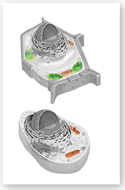Organelles That Capture and Release Energy
 What are the functions of chloroplasts and mitochondria?
What are the functions of chloroplasts and mitochondria?
All living things require a source of energy. Factories are hooked up to the local power company, but how do cells get energy? Most cells are powered by food molecules that are built using energy from the sun.

Chloroplasts Plants and some other organisms contain chloroplasts (KLAWR uh plasts). Chloroplasts are the biological equivalents of solar power plants.  Chloroplasts capture the energy from sunlight and convert it into food that contains chemical energy in a process called photosynthesis. Two membranes surround chloroplasts. Inside the organelle are large stacks of other membranes, which contain the green pigment chlorophyll.
Chloroplasts capture the energy from sunlight and convert it into food that contains chemical energy in a process called photosynthesis. Two membranes surround chloroplasts. Inside the organelle are large stacks of other membranes, which contain the green pigment chlorophyll.
Mitochondria Nearly all eukaryotic cells, including plants, contain mitochondria (myt oh KAHN dree uh; singular: mitochondrion). Mitochondria are the power plants of the cell.  Mitochondria convert the chemical energy stored in food into compounds that are more convenient for the cell to use. Like chloroplasts, two membranes—an outer membrane and an inner membrane—enclose mitochondria. The inner membrane is folded up inside the organelle, as shown in Figure 7–12.
Mitochondria convert the chemical energy stored in food into compounds that are more convenient for the cell to use. Like chloroplasts, two membranes—an outer membrane and an inner membrane—enclose mitochondria. The inner membrane is folded up inside the organelle, as shown in Figure 7–12.
One of the most interesting aspects of mitochondria is the way in which they are inherited. In humans, all or nearly all of our mitochondria come from the cytoplasm of the ovum, or egg cell. This means that when your relatives are discussing which side of the family should take credit for your best characteristics, you can tell them that you got your mitochondria from Mom!
Another interesting point: Chloroplasts and mitochondria contain their own genetic information in the form of small DNA molecules. This observation has led to the idea that they may be descended from independent microorganisms. This idea, called the endosymbiotic theory, is discussed in Chapter 19.

FIGURE 7–12 Cellular Powerhouses Chloroplasts and mitochondria are both involved in energy conversion processes within the cell. Infer What kind of cell—plant or animal—is shown in the micrograph? How do you know?
dTable of Contents
- Formulas and Equations
- Applying Formulas and Equations
- Mean, Median, and Mode
- Estimation
- Using Measurements in Calculations
- Effects of Measurement Errors
- Accuracy
- Precision
- Comparing Accuracy and Precision
- Significant Figures
- Calculating With Significant Figures
- Scientific Notation
- Calculating With Scientific Notation
- Dimensional Analysis
- Applying Dimensional Analysis




